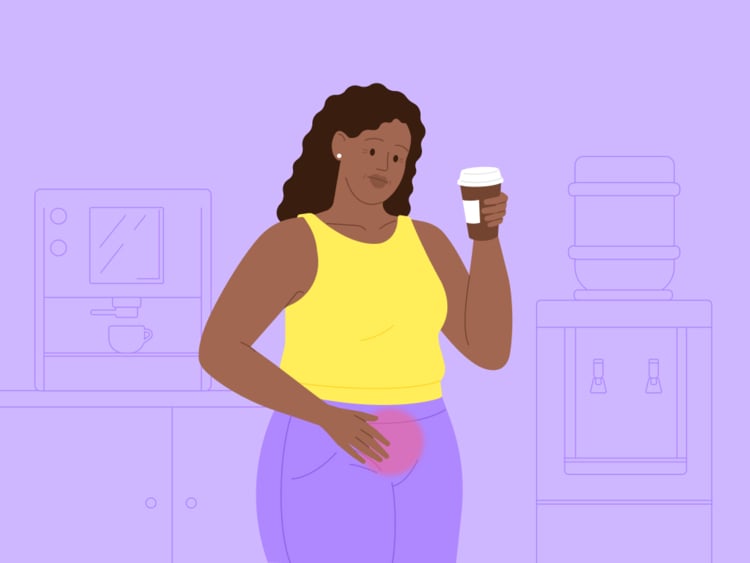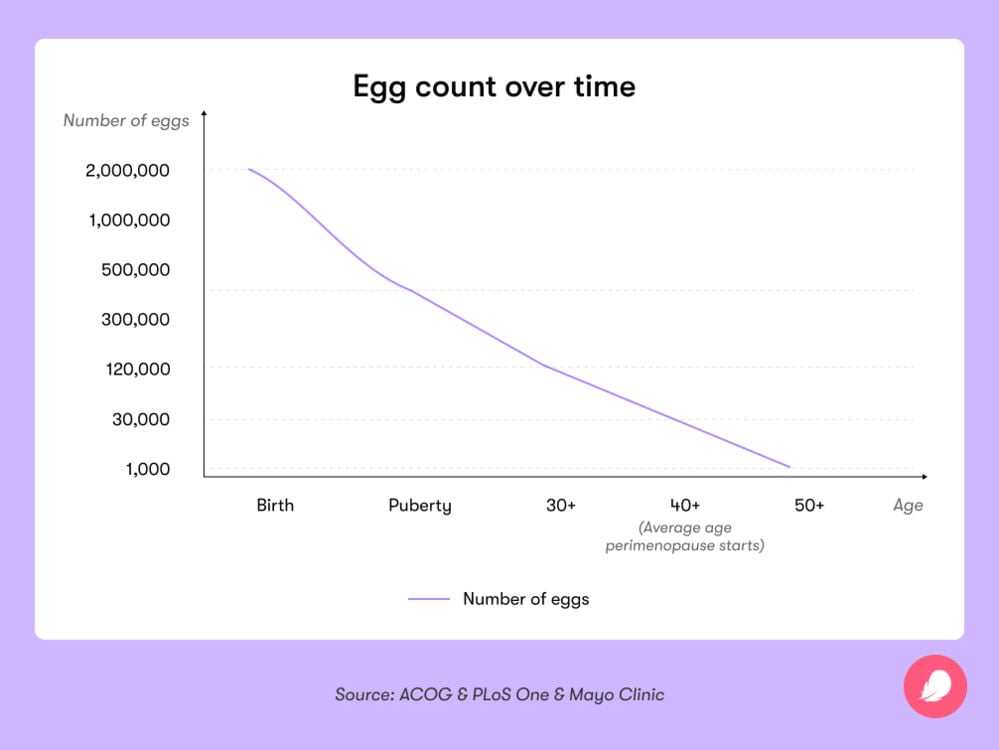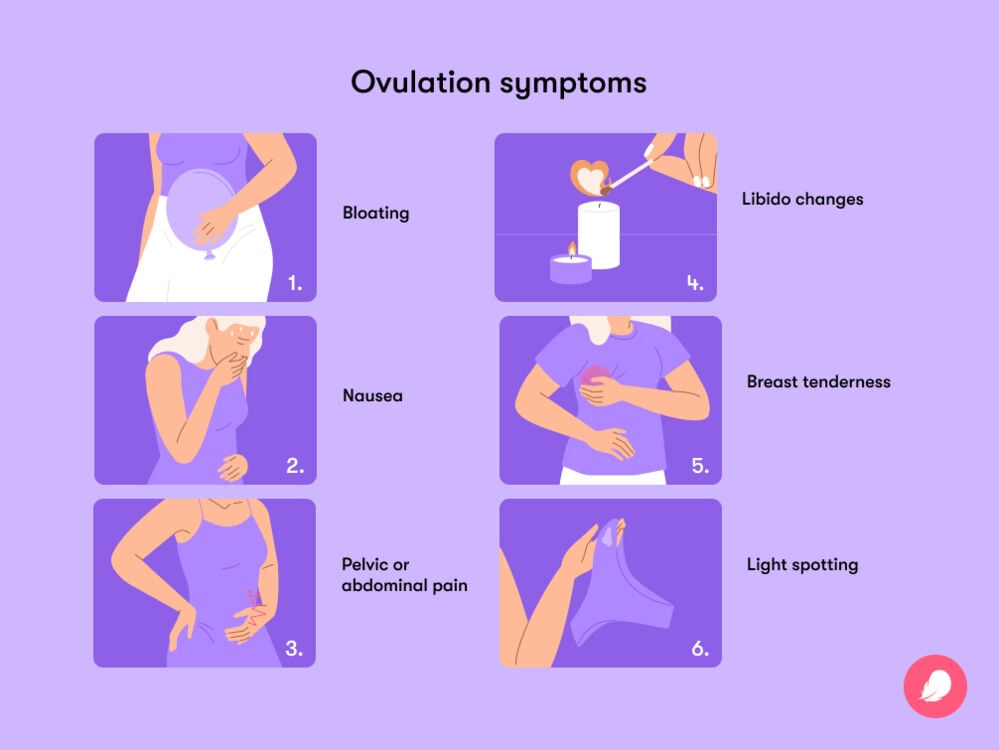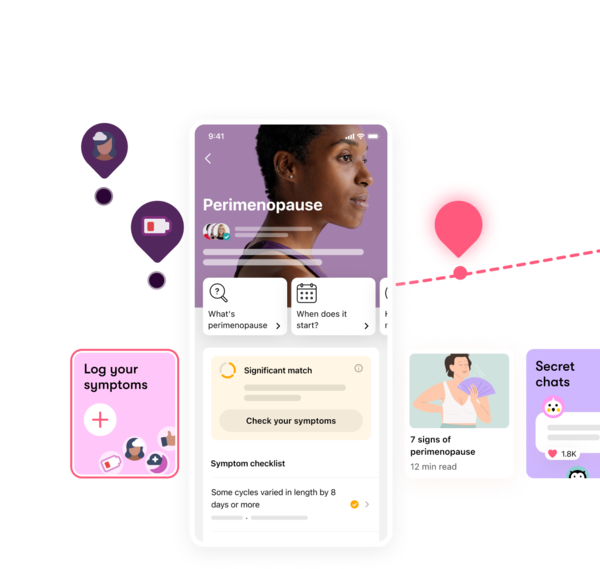If you’re not sure if you’re still fertile in perimenopause, learn the signs and symptoms of ovulation and figure out if there’s still a chance of getting pregnant.
-
Tracking cycle
-
Getting pregnant
-
Pregnancy
-
Help Center
-
Flo for Partners
-
Anonymous Mode
-
Flo app reviews
-
Flo Premium New
-
Secret Chats New
-
Symptom Checker New
-
Your cycle
-
Health 360°
-
Getting pregnant
-
Pregnancy
-
Being a mom
-
LGBTQ+
-
Quizzes
-
Ovulation calculator
-
hCG calculator
-
Pregnancy test calculator
-
Menstrual cycle calculator
-
Period calculator
-
Implantation calculator
-
Pregnancy weeks to months calculator
-
Pregnancy due date calculator
-
IVF and FET due date calculator
-
Due date calculator by ultrasound
-
Medical Affairs
-
Science & Research
-
Pass It On Project New
-
Privacy Portal
-
Press Center
-
Flo Accuracy
-
Careers
-
Contact Us
What are the signs you’re still ovulating in perimenopause?


Every piece of content at Flo Health adheres to the highest editorial standards for language, style, and medical accuracy. To learn what we do to deliver the best health and lifestyle insights to you, check out our content review principles.
Are you trying to conceive? If you’ve been planning to get pregnant, you may well know that ovulation tracking is a helpful way to identify your fertile window, the part of your cycle you need to pay attention to. Because you only have one fertile window each month, keeping track of when you might be ovulating (when your ovary releases an egg) and other symptoms can help you to understand your most fertile days, which is the time you’re most likely to get pregnant.
However, it’s no secret that you’re not fertile forever. In fact, your fertility gradually starts to decline in your late 30s, before stopping altogether when you hit menopause (which is the name given to your last ever period). Your ability to have a baby doesn’t stop overnight, though. It winds down slowly throughout your later reproductive years and during the transition through menopause, which is called perimenopause.
It is technically possible to get pregnant during perimenopause, although it’s harder, may take longer to happen, and does bring a slightly higher chance of miscarriage. But don’t lose hope. If you think perimenopause might be approaching, and you want to have a baby without fertility treatments, learning about how your cycle changes with age is a great place to start. Read on to find out more.
Key takeaways
- Periods becoming more irregular is usually one of the first symptoms of perimenopause.
- Even if your periods are irregular, it’s possible to ovulate, which means you still have a chance of getting pregnant.
- Ovulation tracking and using an app like Flo to keep a log of your cycle and symptoms can help you better understand your fertile days.
- Signs of ovulation are the same during perimenopause as they were before.
- If you’ve been struggling to get pregnant, make an appointment with your doctor. They can help figure out what might be going on and can help you with treatment options if necessary.
- As always, if you have any questions or concerns about your reproductive health, reach out to your doctor for advice.
Remember: The Flo app is for informational purposes only and should not be used as birth control or to aid conception.
Do you ovulate during perimenopause?
Even if your menstrual cycle is unpredictable during the transition through menopause, as long as you’re still getting a period, then you are still ovulating. So yes, “Ovulation still occurs in perimenopause,” says obstetrician and gynecologist Dr. Sara Twogood, Cedars-Sinai Medical Group, California, US. “Just more irregularly and infrequently than in normal reproductive years.”
By the time you reach menopause, however, you don’t ovulate anymore. Confusingly, the terms menopause and perimenopause are often used interchangeably, but they’re two separate things. “Perimenopause is the transitional time into menopause,” explains Dr. Twogood. It covers the years leading up to menopause and the 12 months after, at which point you can be sure your periods have stopped. Perimenopause usually happens in your 40s, but for some people it starts earlier or later than that, anywhere between your 30s and 50s.
It can take up to eight years of perimenopause for you to reach the end of your menstrual cycles, although on average it lasts about four years. But as long as you’re still getting periods, then you’re still ovulating, which means you still have a chance of getting pregnant.
“It is unlikely as the ovulation is [less regular] and the quality of the egg [reduces],” explains Dr. Twogood, “but it is still possible.”
Once you’ve gone through menopause (which most commonly happens between the ages of 45 and 55), you will stop ovulating. “Menopause is defined as no period for 12 months,” explains Dr. Twogood. From then on, you are postmenopausal, and you won’t be able to get pregnant without using fertility treatments.
If you need a refresh on how your menstrual cycles work to enable pregnancy, let’s recap. When your periods start, you begin releasing an egg every month (ovulation) in preparation for potentially getting pregnant. If sperm fertilizes this egg, it will move into your uterus, where it can implant itself into your uterine lining and result in a pregnancy. If fertilization doesn’t happen, the lining of your uterus starts to shed, which is your period.
You’re born with all the eggs you’ll ever have, and over time, both the number and quality of these eggs start to reduce. During perimenopause, your ovaries gradually change the way they produce hormones. “When your ovaries ovulate less frequently and produce less estrogen, [this] causes irregular periods and a variety of other symptoms,” explains Dr. Twogood.

Everyone experiences it differently, but some of the other perimenopause symptoms that can happen while your body adjusts to changing hormone levels include hot flashes, night sweats, and mood swings. Not everyone finds these difficult to manage, but if they’re interfering with your life, reach out to a medical professional for coping strategies or treatment options.
If you think you might have started perimenopause and you want to have a baby, it’s a good idea to talk to your doctor. The usual advice is to wait until you’ve been trying to get pregnant for six months if you’re over the age of 35, but if you have irregular cycles, that’s a reason to see someone right away.
Does ovulation get painful in perimenopause?
When you ovulate at any time — whether you’re in perimenopause or not — you might notice some light cramping in the lower part of your abdomen similar to period pains. These mild cycle-related cramps, also known as mittelschmerz (a German word that means “middle pain” or “pain in the middle of the month”) are fairly common and usually short lived.
But ovulation shouldn’t be intensely painful, so if it doesn’t stop and painkillers don’t help, be sure to reach out to your doctor to make sure everything is OK. “Anecdotally, I have seen my patients more aware of ovulation in perimenopause,” says Dr. Twogood. “But in general, painful ovulation is not one of the typical or common signs of perimenopause.”
What are the signs and symptoms of ovulation during perimenopause?
Ovulation is a regular part of your menstrual cycle, but everyone experiences it differently, which can make it tricky to pinpoint exactly when it might happen. Keeping an eye on your signs and symptoms using a cycle-tracking app like Flo can help you to learn when you might be about to ovulate, whether you’re perimenopausal or not.
Learning how to track these changes can give you some important clues about your fertile window, which may be helpful if you’re trying to conceive. And once you know your body’s signals, they’re unlikely to change as you move into perimenopause. “Signs and symptoms of ovulation during perimenopause are the same as signs and symptoms during the earlier reproductive years,” says Dr. Twogood.
Take a quiz
Find out what you can do with our Health Assistant
Signs and symptoms of ovulation will differ for everyone but may include:
- Cervical mucus changes: One to two days before ovulation, your vaginal discharge, which contains cervical mucus, may become stretchy and slippery — similar to raw egg whites.
- Body temperature changes: After ovulation, you might notice a small rise in your basal body temperature (that’s the temperature of your body when you’re resting) of around 0.5ºF (0.3ºC).
- Breast tenderness: The rush of hormones before and during ovulation can lead to breast soreness and tenderness. This can range from mild breast pain that’s barely noticeable to severe pain that makes sudden movements and high-intensity exercise uncomfortable.
- Pelvic or abdominal pain: While generally ovulation shouldn’t hurt, you might feel a slight twinge in the lower part of your abdomen around this part of your cycle. Remember, you’ll usually only feel this on one side, depending on which ovary has released an egg. While it may be uncomfortable, rest assured that this kind of cramping is normal and should subside. If it doesn’t stop, be sure to reach out to your doctor to make sure everything is OK.
- Bloating: Because of hormonal changes, feeling bloated around the middle of your cycle can be another symptom of ovulation. If it’s making you feel uncomfortable, then staying hydrated and eating smaller meals could help.
- Light spotting: Some people experience light bleeding or spotting during ovulation. Again, this is no immediate cause for concern, but if it lasts longer than a day or two or becomes particularly heavy, reach out to your doctor.
- Sex drive changes: Due to a rise in levels of the hormone estrogen, just before ovulation you might feel more aroused than usual. This could be your body’s way of making the most of your fertile window. If your desire for sex dips after a few days (or you don’t feel any different), this is totally normal, too.
- Cervical position: Your cervix — the small canal that connects your uterus to your vagina — actually changes position throughout your menstrual cycle. “During ovulation the cervix is soft and higher in the vagina and pelvis,” says Dr. Twogood. “The cervical os (the opening to the cervix) is more open to allow sperm easier access into the uterus and uterine tubes.” This isn’t visible outside of the body, though, which makes it one of the more complicated ways to check if you’re fertile.
Remember that everyone experiences ovulation differently. You can figure out when it might be happening for you by logging any of the signs and symptoms above in the Flo app.

How to track ovulation during perimenopause
As you approach menopause, getting pregnant through sex can become more difficult, so you may need to discuss possible fertility treatment options with your doctor. If you’re over the age of 40, for example, and you’d like to have a baby, it’s advised you see someone right away. But as long as you have a period and you still ovulate — even if your periods are irregular — you can still get pregnant via unprotected sex.
Tracking your ovulation can help you learn how your body signals that you’re in your fertile window, which may be helpful if you want to get pregnant. The process is largely the same whether you’re in perimenopause or not. The only difference is that hormone-related changes can make your menstrual cycle more unreliable, which might make it harder to predict ovulation.
There are several ways you can estimate the best time in your cycle to have sex to get pregnant. But it’s worth noting that it can be trickier to get a reliable prediction for ovulation during perimenopause using any of the following methods because your cycles are irregular:
The calendar method
Using a paper calendar or an app like Flo to track your menstrual cycle over several months can help you understand your body’s patterns and predict the signs of ovulation, although it’s important to note this isn’t always 100% reliable. Everyone is different, and it can even change from month to month, but you can usually get some idea of when ovulation will fall by the length of your cycle. However, Dr. Twogood warns that this method can be even less dependable when you’re in perimenopause. “This is not a reliable way to [identify] ovulation during perimenopause because periods can become more irregular and unpredictable. During reproductive years, I typically recommend using two methods to track ovulation: calendar method and one other — whichever you feel best about!”
Ovulation prediction kits
An ovulation prediction kit (OPK) works by measuring your body’s level of luteinizing hormone (LH) through your urine. You’ll get a surge of this hormone just before you ovulate, so it’s a good signal that ovulation is about to occur, which is very useful information if you’re trying for a baby.
Dr. Twogood recommends using OPKs in combination with tracking your cycle. “Start testing several days before you are predicted to ovulate based on the calendar method,” she says. “Doing this, patients can limit the amount of time they are testing. During perimenopause, ovulation is more infrequent and irregular, so the calendar method is not as reliable to predict timing of ovulation based on prior cycles.” It’s also important to note that OPKs can become less accurate during the perimenopause phase, “because the body may be releasing LH to try to ovulate, but ovulation does not occur,” adds Dr. Twogood.
Tracking your body’s signs
Whether you like to keep an eye on your cervical mucus to see when it starts to change, look out for telltale light cramps, or prefer to check your cervix, you can learn your body’s way of telling you ovulation is close. Not sure where to start? The Flo app has all the expert information you need to help you read your body’s fertility signals, plus you can log symptoms throughout your cycle so it’s easier to spot patterns.
Basal body temperature (BBT) monitoring
“Your BBT increases slightly after ovulation,” explains Dr. Twogood. By recording it each day using a special thermometer, after a few cycles you can predict when you’re most likely to ovulate.
Even though the rise is small, you may be able to notice the change on a digital thermometer if you consistently track your temperature around the same time each day of your menstrual cycle, preferably first thing in the morning. This method is more helpful for checking after you’ve ovulated, however, rather than giving you advance warning you’re about to, which can make it less useful if you’re in perimenopause and have irregular cycles. But it can still be useful information if you’re hoping to get pregnant.
Frequently asked questions about ovulation symptoms during perimenopause
What is perimenopause?
Perimenopause is your transition through menopause. It covers the years leading up to menopause (your last ever period) and the 12 months after, when you can be sure you’ve reached menopause. During the transition, the amount of estrogen your ovaries produce begins to fluctuate, which can cause symptoms such as hot flashes, brain fog, and changes to your period.
What are the signs and symptoms of perimenopause?
Everyone is different when it comes to perimenopause, but changes to your hormones can cause a number of symptoms, including hot flashes and night sweats. People may also notice symptoms like mood swings, joint pain, and brain fog during this time.
Can you get pregnant after you reach menopause?
We’re often led to believe that you can’t get pregnant after 40 without the help of fertility treatment. While fertility and age are closely connected, that’s not always the case. Once you’ve gone through menopause, you won’t be able to get pregnant through sex. But it is still possible in your later reproductive years and even during the menopause transition, known as perimenopause. If you’re hoping to have a baby during perimenopause, speak to your doctor or a fertility specialist.


Hey, I'm Anique
I started using Flo app to track my period and ovulation because we wanted to have a baby.


The Flo app helped me learn about my body and spot ovulation signs during our conception journey.


I vividly
remember the day
that we switched
Flo into
Pregnancy Mode — it was
such a special
moment.
Real stories, real results
Learn how the Flo app became an amazing cheerleader for us on our conception journey.
References
“Advanced Maternal Age.” Cleveland Clinic, my.clevelandclinic.org/health/diseases/22438-advanced-maternal-age. Accessed 2 Dec. 2024.
“Ask the Sexpert: Sex Drive and the Menstrual Cycle.” University of Rochester University Health Service, 25 Jan. 2023, www.rochester.edu/uhs/ask-the-sexpert-sex-drive-and-the-menstrual-cycle/.
“Basal Body Temperature for Natural Family Planning.” Mayo Clinic, 10 Feb. 2023, www.mayoclinic.org/tests-procedures/basal-body-temperature/about/pac-20393026.
“Bloating.” NHS, www.nhs.uk/conditions/bloating/. Accessed 2 Dec. 2024.
“Breast Pain (Mastalgia).” Johns Hopkins Medicine, www.hopkinsmedicine.org/health/conditions-and-diseases/mastalgia-breast-pain. Accessed 2 Dec. 2024
“Can Tracking Your Basal Body Temperature Help You Conceive?” Cleveland Clinic, 7 May 2021, health.clevelandclinic.org/can-tracking-your-basal-body-temperature-help-you-conceive.
“Cervical Mucus.” Cleveland Clinic, my.clevelandclinic.org/health/body/21957-cervical-mucus. Accessed 2 Dec. 2024.
“Cervix.” Cleveland Clinic, my.clevelandclinic.org/health/body/23279-cervix. Accessed 2 Dec. 2024.
“Conception.” Cleveland Clinic, my.clevelandclinic.org/health/articles/11585-conception. Accessed 2 Dec. 2024.
Delamater, Lara, and Nanette Santoro. “Management of the Perimenopause.” Clinical Obstetrics and Gynecology, vol. 61, no. 3, Sep. 2018, pp. 419–32, https://doi.org/10.1097/grf.0000000000000389.
“Estrogen.” Cleveland Clinic, my.clevelandclinic.org/health/body/22353-estrogen. Accessed 2 Dec. 2024.
“Female Age-Related Fertility Decline.” The American College of Obstetricians and Gynecologists, Mar. 2014, www.acog.org/clinical/clinical-guidance/committee-opinion/articles/2014/03/female-age-related-fertility-decline.
“Fertility Awareness-Based Methods of Family Planning.” The American College of Obstetricians and Gynecologists, Jan. 2019 www.acog.org/womens-health/faqs/fertility-awareness-based-methods-of-family-planning.
“Having a Baby after Age 35: How Aging Affects Fertility and Pregnancy.” The American College of Obstetricians and Gynecologists, Feb. 2023, www.acog.org/womens-health/faqs/having-a-baby-after-age-35-how-aging-affects-fertility-and-pregnancy.
“Irregular Periods.” NHS, www.nhs.uk/conditions/irregular-periods/. Accessed 2 Dec. 2024.
Lewis, Rhys. “Blastocyst Attaching to the Wall of the Uterine Cavity.” MSD Manual Consumer Version, www.msdmanuals.com/home/multimedia/video/blastocyst-attaching-to-the-wall-of-the-uterine-cavity. Accessed 2 Dec. 2024.
“Menopause Basics.” Office on Women’s Health, 17 Oct. 2024, www.womenshealth.gov/menopause/menopause-basics.
“Menopause.” Mayo Clinic, 7 Aug. 2024, www.mayoclinic.org/diseases-conditions/menopause/symptoms-causes/syc-20353397.
“Menopause.” World Health Organization, 16 Oct. 2024, www.who.int/news-room/fact-sheets/detail/menopause.
“Menstrual Cycle: What’s Normal, What’s Not.” Mayo Clinic, 22 Apr. 2023, www.mayoclinic.org/healthy-lifestyle/womens-health/in-depth/menstrual-cycle/art-20047186.
Ogle, Alicia. “Using Ovulation Tools to Predict Fertility.” Mayo Clinic Health System, 13 June 2023, www.mayoclinichealthsystem.org/hometown-health/speaking-of-health/using-ovulation-kits-to-predict-fertility.
“Ovulation.” Cleveland Clinic, my.clevelandclinic.org/health/articles/23439-ovulation. Accessed 2 Dec. 2024.
“Ovulation Pain.” Cleveland Clinic, my.clevelandclinic.org/health/diseases/9134-ovulation-pain-mittelschmerz. Accessed 2 Dec. 2024.
“Perimenopause.” Cleveland Clinic, my.clevelandclinic.org/health/diseases/21608-perimenopause. Accessed 2 Dec. 2024.
“Perimenopause.” Mayo Clinic, 25 May 2023, www.mayoclinic.org/diseases-conditions/perimenopause/symptoms-causes/syc-20354666.
Tower, Clare. “Pregnancy in Peri- and Postmenopausal Women: Challenges in Management.” Menopause International, vol. 15, no. 4, Dec. 2009, pp. 165–68, https://doi.org/10.1258/mi.2009.009040.
Wallace, W. Hamish B., and Thomas W. Kelsey. “Human Ovarian Reserve from Conception to the Menopause.” PLOS ONE, vol. 5, no. 1, Jan. 2010, https://doi.org/10.1371/journal.pone.0008772.
“What Is Menopause?” National Institute on Aging, www.nia.nih.gov/health/menopause/what-menopause. Accessed 2 Dec. 2024.
“What Ovulation Signs Can I Watch For if I Want to Get Pregnant?” Mayo Clinic, 9 July 2024, www.mayoclinic.org/healthy-lifestyle/getting-pregnant/expert-answers/ovulation-signs/faq-20058000.
Witt, Barry. “Trying to Get Pregnant? Here’s When to Have Sex.” The American College of Obstetricians and Gynecologists, Aug. 2023, www.acog.org/womens-health/experts-and-stories/the-latest/trying-to-get-pregnant-heres-when-to-have-sex.
History of updates
Current version (06 December 2024)
Published (03 January 2025)
In this article

Track your perimenopause journey in the Flo app
-
Log symptoms and get tips to manage them
-
Learn what to expect with expert-led articles and videos
-
Connect with others who can relate to how you're feeling




